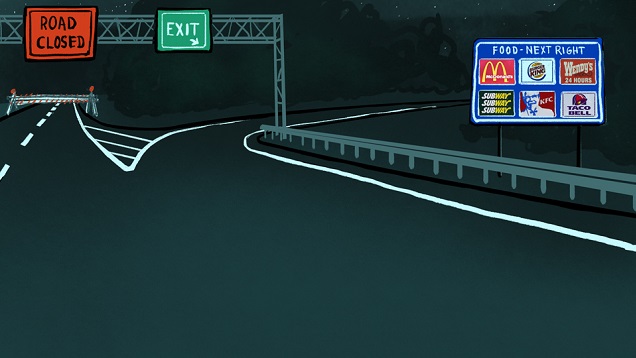Fast food can be difficult to avoid even for people watching their weight. When you’re on the road or it’s late at night, it’s usually your only option. Other times, you just feel like a one-off treat. All of these scenarios are fine – but you need to be careful not to overdo it. These menu tips will help to fill you up without filling you out.
Illustration by Tara Jacoby.
General Guidelines for Finding the Least Unhealthy Options
Let’s just come out and say it: fast food is generally not healthy. It’s all processed and packed with sodium, unhealthy fats, and excess preservatives. When you compare it to meals you could make at home, there’s obviously no way that fast food could be considered healthy options.
As Andy Bellatti, Registered Dietician, explains:
It is important to recognise that when it comes to chains like McDonald’s, Wendy’s, and Burger King, it isn’t so much about “healthy options”, but rather about “what is the least worst?” This is an important distinction to make.
So as long as you approach those “I have to eat something” roadtrip moments with that mindset, you’ll find it to be a less stressful experience. As Bellatti puts it, there’s more to fast food than the nutrition facts:
We have to get away from the concept that a meal is “healthy” because it contains fewer than X number of calories or because it has X grams of protein. The issue with most fast food items is that even if they are among the ‘better’ choices, they are usually cooked in unhealthy oils and offer very little in terms of fibre, vitamins, and minerals.
With all of that in mind, Bellati suggests that there are a few tips you can follow at most chains to find those food items that are the lesser of evils:
- Avoid fried foods when possible.
- Opt for smaller portions if they’re available (or share food with someone).
- Pass on sugary beverages like soft drinks, and drink water instead.
- Be wary of sauces (including dressings and dips) because they can be high in sugar and sodium.
- Say no to mayo. It can save you a lot of calories and fat.
- When in doubt, use your smartphones to look up nutrition information and healthy options.
Doing some research is especially helpful if you have special dietary restrictions. Something reasonable for one person could be really unhealthy for another, so don’t hesitate to check nutrition facts online or ask for them at the counter or drive-thru.
Things That Seem Healthier, but Aren’t
Some fast food items are marketed as being the “healthy” option, but don’t be fooled. Salads,or things that call themselves salads,are the biggest abusers of this. Don’t ever assume that something called a salad is healthy. For example, the Gourmet Crispy Chicken Caesar Salad is not very healthy at all. It’s packed with more fat and sodium than a Big Mac, before you even add any dressing to it.
You should also be careful of things labelled “premium.” This can give off the vibe that the ingredients are higher quality, and thus healthier, but it’s rarely the case. The same goes for restaurant chains that heavily market their “fresh” ingredients. Fresh does not mean healthy.
Lastly, be wary of vegetarian options. Just because something is vegetarian or made without meat doesn’t mean that it’s healthier. For example, the Hungry Jack’s Veggie Burger might seem like it’s a healthier option than a regular burger, but it’s actually packed with sodium and potentially worse for you than a Whopper Jr. Remember, when in doubt, always double check by looking up the fast food chain’s menu and nutrition facts.
Eating a Little Fast Food Isn’t the End of the World
While it’s good to avoid the worst stuff when you eat at these places, it’s important to keep everything in perspective. Bellatti explains that eating fast food every once in a while won’t ruin your whole diet, so don’t let it get you down:
When it comes to nutrition, it is the big picture that matters. If you find yourself in a situation where your options are either Wendy’s or McDonald’s four or five times a year — and the bulk of your diet is low in processed foods, rich in whole plant-foods, and you avoid or strictly limit sugar-sweetened beverages — then those four or five meals are the exception to the rule and are truly not worth worrying about. The problem, of course, is that the average American diet is in such a crummy state (low in fruits and vegetables, high in added sugars, high in red meat) that fast food meals only exacerbate the problem.
Essentially, don’t sweat it too much if you have to grab some Mickey D’s on your long drive. What’s important is not making it a habit and that you build other healthier habits instead. Yes, you want to try and still avoid the really bad stuff at these fast food joints, but a burger or two won’t set you back completely.

Comments